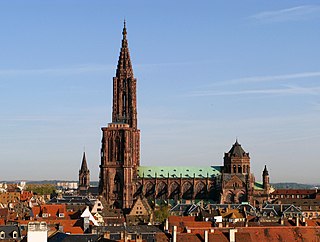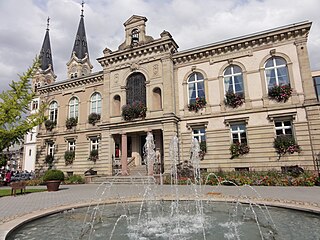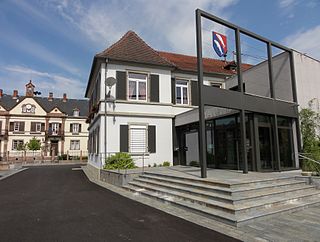
Strasbourg is the prefecture and largest city of the Grand Est region of Eastern France and the official seat of the European Parliament. Located at the border with Germany in the historic region of Alsace, it is the prefecture of the Bas-Rhin department.

Alsace is a cultural region and a territorial collectivity in Eastern France, on the west bank of the upper Rhine next to Germany and Switzerland. In 2017, it had a population of 1,889,589.

Saverne is a commune in the Bas-Rhin department in Grand Est in north-eastern France. It is situated on the Rhine-Marne canal at the foot of a pass over the Vosges Mountains, and 45 km (27 mi) N.W. of Strasbourg.

Bas-Rhin is a department in Alsace which is a part of the Grand Est super-region of France. The name means 'Lower Rhine', however, geographically speaking it belongs to the Upper Rhine region. It is, with the Haut Rhin, one of the two departments of the traditional Alsace region. The more populous and densely populated of the pair, it had 1,125,559 inhabitants in 2017. The prefecture is based in Strasbourg. The INSEE and Post Code is 67.

Sélestat is a commune in the Grand Est region of France. An administrative division (sous-préfecture) of the Bas-Rhin department, the town lies on the Ill river, 17 kilometres (11 mi) from the Rhine and the German border. Sélestat is located between the largest communes of Alsace, Strasbourg and Mulhouse.

Schiltigheim is a commune in the Bas-Rhin department in Grand Est in north-eastern France.

Bischwiller is a commune in the Bas-Rhin department in Grand Est in northeastern France just west of the Moder River.

Illkirch-Graffenstaden is a commune in the Bas-Rhin department in Grand Est in north-eastern France. It is the second-largest suburb of the city of Strasbourg, and is adjacent to it on the south-southwest. Illkirch-Graffenstaden is one of the fastest growing cities in France and probably in Europe, its population having more than doubled in fifty years.

Huttenheim is a commune in the Bas-Rhin department in Grand Est in north-eastern France.

Souffelweyersheim is a commune in the Bas-Rhin department in Grand Est in north-eastern France, and is part of metropolitan Strasbourg.

Avolsheim is a commune in the Bas-Rhin department in the Grand Est region of north-eastern France.

Auenheim is a former commune in the Bas-Rhin department in the Grand Est region of north-eastern France. On 1 January 2019, it was merged into the new commune Rountzenheim-Auenheim.

Barr is a commune in the Bas-Rhin department in the Alsace region of north-eastern France.

Innenheim is a commune in the Bas-Rhin department in Alsace in north-eastern France.

Baldenheim is a commune in the Bas-Rhin department in the Alsace region of north-eastern France.

Bassemberg is a commune in the Bas-Rhin department in the Alsace region of north-eastern France.

Herrlisheim is a commune in the Bas-Rhin department in Grand Est in north-eastern France. The town dates from the 8th century. Herrlisheim was the scene of very heavy fighting during Operation Nordwind, an offensive launched by the German Army during World War II that inflicted considerable damage to the town.

Hilsenheim is a commune in the Bas-Rhin department in Alsace in north-eastern France.

Issenhausen is a commune in the Bas-Rhin department in Grand Est in north-eastern France.

Limersheim is a commune in the Bas-Rhin department in Alsace in north-eastern France. It is a tourist attraction with destinations such as the heritage site Strasbourg Grand Ile and villages like Hunawihr and Riquewihr.
























